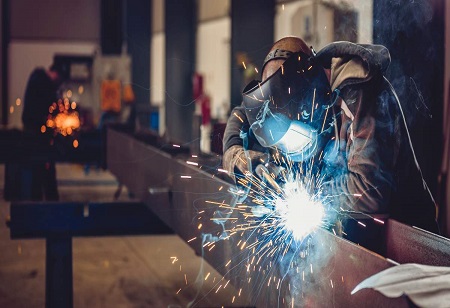
ESAB, a provider of welding equipment and filler metal, along with NYC Constructors, a steel erector, recently marked a milestone with a "topping off" event held at the new JPMorgan Chase headquarters in New York City. The executives participating in the event autographed the last steel support before it was lifted and positioned on the pinnacle of the 60-story building, which stands at a height of 1,388 feet.
“We are proud to have partnered with ESAB to successfully complete another high-rise in New York City,” said Barry King, president of NYC Constructors. “At just under 94,000 tons of structural steel, 270 Park Ave. required 170,000 lbs. of field welds, a staggering amount we could not have achieved without the support of ESAB.”
The global push toward sustainable and renewable energy sources has ushered in a new era of technological advancements and infrastructure development. One industry that stands at the forefront of this transition is welding, playing a crucial role in the fabrication and assembly of renewable energy components. This article delves into the myriad ways in which the growth of renewable energy is catalyzing an unprecedented demand for welding equipment.
Wind Energy Boom and the Need for Precision Welding
The wind energy sector has witnessed an exponential surge in recent years, with wind turbines becoming synonymous with the clean energy landscape. Towering structures, known as wind turbines, harness the power of the wind to generate electricity. The construction of these turbines involves intricate welding processes to ensure the structural integrity and longevity of the components.
Wind turbine components, such as tower structures and nacelles, require precise and robust welding to withstand the harsh environmental conditions they face. The demand for skilled welders equipped with advanced welding equipment has surged in tandem with the expansion of wind energy projects globally.
“The demand for welding machines has been increasing in various industries, including power, construction, automotive, and heavy engineering. The government's emphasis on the construction of infrastructure and the strong demand for welding equipment in India are the main factors driving the growth of this industry,” says Additya Bhide, CEO, Oorja Weld Tech.
Solar Power and the Role of Welding in Panel Manufacturing
Solar power, another key player in the renewable energy portfolio, relies heavily on photovoltaic panels to convert sunlight into electricity. The manufacturing and assembly of solar panels involve complex welding processes for the frames and mounting structures.
Welding plays a critical role in ensuring the durability and efficiency of solar panels. As the solar energy industry continues to grow, propelled by advancements in technology and decreasing costs, the demand for welding equipment tailored for solar panel fabrication is experiencing a parallel rise.
Pemamek has introduced an innovative solution for the assembly and welding of tubular and conical workpieces in manufacturing.
Hydropower, Tidal Energy, and the Underwater Welding Challenge
Beyond wind and solar, hydropower and tidal energy projects contribute significantly to the renewable energy mix. Dams, turbines, and underwater structures are integral components of these projects, and welding becomes a challenging yet essential process, especially underwater.
Underwater welding, a specialized skill set, is required for the construction and maintenance of tidal energy systems. As the interest in harnessing energy from water resources intensifies, so does the demand for welders equipped with underwater welding expertise and specialized equipment.
Aquatiq Diving utilizes the most advanced equipment to provide top-quality Underwater Welding & Cutting Service. The team of professionals successfully carries out this service by immersing themselves deep underwater. Professionals undertake the appropriate welding measures on the specific area of the ship located in the submerged part of the port.
Energy Storage Systems and the Welding Connection
The renewable energy landscape is not only about power generation but also about effective energy storage solutions. Advanced batteries and energy storage systems are key to ensuring a consistent and reliable power supply from intermittent renewable sources. Welding is fundamental to the manufacturing of battery components, from the assembly of battery cells to the fabrication of housing and connectors.
The burgeoning demand for energy storage solutions, driven by the need to store excess energy generated by renewables, directly correlates with an increased demand for welding equipment that can meet the precision and safety standards required in battery production.
American Friction Welding one of the leading manufacturers of friction welded components for the power generation industry has the ability to weld parts of dissimilar metals, grades, thicknesses, and shapes makes its welding process the perfect solution in energy production.
Transmission and Distribution Networks: The Backbone of Renewable Energy
“Nowadays, welding equipment is primarily equipped with Inverter-based technology which is assembled using electronic components. An important factor for any electronic component is its reliability and the selection of the right components for product performance. Another challenge facing the welding equipment market is voltage fluctuations in input power supply lines,” says Sachin Dobhada, Head of Research, Development & Quality (Equipment), Ador Welding.
The expansion of renewable energy capacity necessitates the development and upgrading of transmission and distribution networks. This includes the construction of power transmission towers, substations, and other critical infrastructure components. Welding is indispensable in these projects, ensuring the structural integrity and reliability of the power grid.
There is a great need for welding equipment that can handle big infrastructure projects because governments and energy companies are investing in the expansion of transmission and distribution networks. This is necessary to support the increasing use of renewable energy in the overall energy mix.
In conclusion, the burgeoning demand for renewable energy is propelling the welding industry into a central role in shaping the future of clean energy. From the towering wind turbines to the underwater structures of tidal energy systems, welding is the linchpin holding together the infrastructure of tomorrow. The mutual dependence between renewable energy growth and the demand for advanced welding equipment signifies a promising trajectory toward a sustainable and interconnected energy landscape.
We use cookies to ensure you get the best experience on our website. Read more...